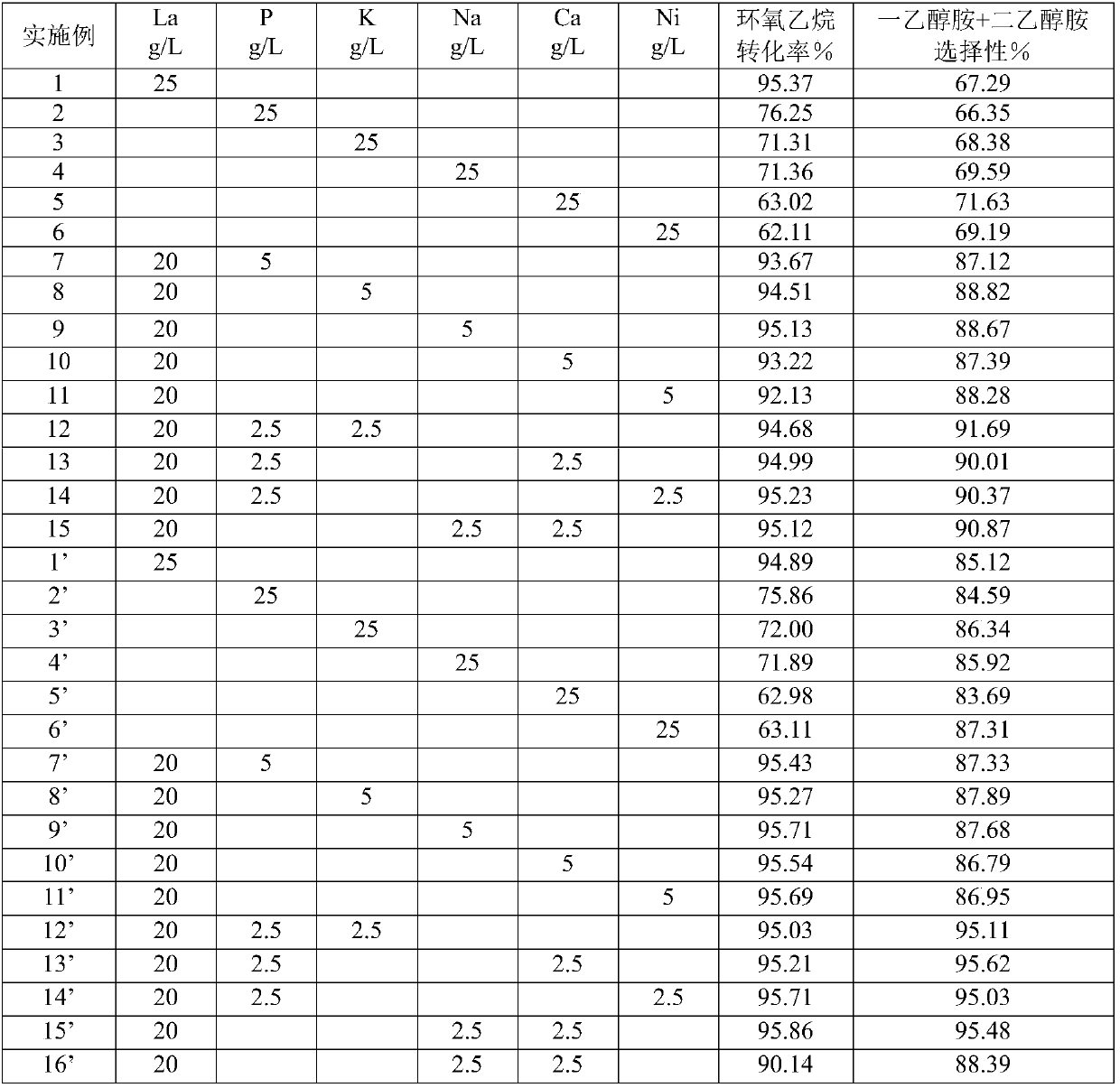Method for yield increasing of monoethanolamine (MEA) and diethanol amine (DEA)
A technology of diethanolamine and ethanolamine, applied in chemical instruments and methods, preparation of organic compounds, preparation of aminohydroxyl compounds, etc., can solve the problems of high energy consumption and high cost
- Summary
- Abstract
- Description
- Claims
- Application Information
AI Technical Summary
Problems solved by technology
Method used
Image
Examples
Embodiment 1
[0056] 1. Molecular sieve preparation
[0057] 40w% silica sol, sodium metaaluminate, tetrapropylammonium bromide (TPABr), sodium chloride, sodium hydroxide and water were mixed successively, stirred for 180 minutes, put into a reaction kettle, and dynamically (200 rpm minutes) crystallized for 72 hours. The crystallized product was quenched, filtered, washed with water until the pH value was 7, and dried at 120°C for 12 hours to obtain the original ZSM-5 molecular sieve powder. The molar ratio of each raw material in the reaction mixture is: SiO 2 / Al 2 o 3 =50,H 2 O / SiO 2 =25.83, NaCl / SiO 2 =0.68, NaOH / SiO 2 =0.15, TPABr / SiO 2 = 0.40.
[0058] The prepared ZSM-5 molecular sieve powder was mixed with 0.2mol L -1 Soak in ammonium nitrate solution with a solid-to-liquid ratio of 1:15, stir under heating at 90°C for 2 hours, then suction filter and wash. This process was repeated three times, and the obtained sample was dried at 120° C. for 6 hours, and finally calcin...
Embodiment 2
[0069] 1. Molecular sieve preparation
[0070] 40w% silica sol, sodium metaaluminate, tetrapropylammonium bromide (TPABr), sodium chloride, sodium hydroxide and water were mixed in turn, stirred for 180 minutes, put into a reaction kettle, and dynamic (200 rpm minutes) crystallized for 72 hours. The crystallized product was quenched, filtered, washed with water until the pH value was 7, and dried at 120°C for 12 hours to obtain the original ZSM-5 molecular sieve powder. The molar ratio of each raw material in the reaction mixture is: SiO 2 / Al 2 o 3 =50,H 2 O / SiO 2 =25.83, NaCl / SiO 2 =0.68, NaOH / SiO 2 =0.15, TPABr / SiO 2 = 0.40.
[0071]The prepared ZSM-5 molecular sieve powder was mixed with 0.2mol L -1 Soak in ammonium nitrate solution with a solid-to-liquid ratio of 1:15, stir under heating at 90°C for 2 hours, then suction filter and wash. This process was repeated three times, and the obtained sample was dried at 120° C. for 6 hours, and finally calcined at 550°...
Embodiment 3
[0082] 1. Molecular sieve preparation
[0083] 40w% silica sol, sodium metaaluminate, tetrapropylammonium bromide (TPABr), sodium chloride, sodium hydroxide and water were mixed in turn, stirred for 180 minutes, put into a reaction kettle, and dynamic (200 rpm minutes) crystallized for 72 hours. The crystallized product was quenched, filtered, washed with water until the pH value was 7, and dried at 120°C for 12 hours to obtain the original ZSM-5 molecular sieve powder. The molar ratio of each raw material in the reaction mixture is: SiO 2 / Al 2 o 3 =50,H 2 O / SiO 2 =25.83, NaCl / SiO 2 =0.68, NaOH / SiO 2 =0.15, TPABr / SiO 2 = 0.40.
[0084] The prepared ZSM-5 molecular sieve powder was mixed with 0.2mol L -1 Soak in ammonium nitrate solution with a solid-to-liquid ratio of 1:15, stir under heating at 90°C for 2 hours, then suction filter and wash. This process was repeated three times, and the obtained sample was dried at 120° C. for 6 hours, and finally calcined at 550...
PUM
| Property | Measurement | Unit |
|---|---|---|
| diameter | aaaaa | aaaaa |
Abstract
Description
Claims
Application Information
 Login to View More
Login to View More - R&D Engineer
- R&D Manager
- IP Professional
- Industry Leading Data Capabilities
- Powerful AI technology
- Patent DNA Extraction
Browse by: Latest US Patents, China's latest patents, Technical Efficacy Thesaurus, Application Domain, Technology Topic, Popular Technical Reports.
© 2024 PatSnap. All rights reserved.Legal|Privacy policy|Modern Slavery Act Transparency Statement|Sitemap|About US| Contact US: help@patsnap.com








